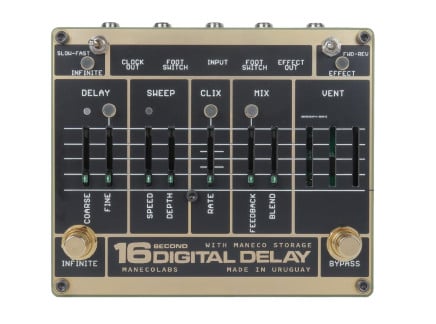We'll be frank—there are a bewildering number of musical tools available for delay and looping these days. Not even counting the boundless world of software applications, between countless effects pedals and cutting-edge Eurorack modules, there are more options than ever for creating trailing echoes and cascading loops with your instrument. But sometimes, it's possible to trace the parallel threads of contemporary, currently-available instruments or effects back in time to a singular product—a point in time where nothing like it had come before and practically everything that followed would owe its existence to this one thing.
As far as digital delay and looper devices go, this one product is the Electro-Harmonix 16 Second Digital Delay pedal. Now considered a rare, legendary machine, the 16 Second Delay was a feat of engineering at the time of its release, boasting sound quality and performance unmatched by any other similar product that you could buy back then. And if you can think of any pedal available today that boasts long delay times and looping functionality, there's a good chance that it wouldn't exist had the 16 Second Delay never been released.
In this article, we'd like to shine a spotlight on the 16 Second Digital Delay, offering some reflections on how this remarkable machine came to be, and how it managed to both exist in a format that was familiar to delay pedals that came before it while managing to offer so many ground-breaking concepts. This pedal is a one-of-a-kind device that, even today, challenges the arbitrary distinction between delay and looper effect, and encourages a more open-minded approach to interaction and play.
EHX in 1983
By the early 1980s, Electro-Harmonix had already established itself as a brand, producing a number of now-legendary guitar effects pedals. From their debut in 1969 with the humble LPB-1 Linear Power Booster, EHX released hit product after hit product throughout the '70s: numerous versions of the Big Muff Pi, the Electric Mistress, the Deluxe Memory Man, and many more.
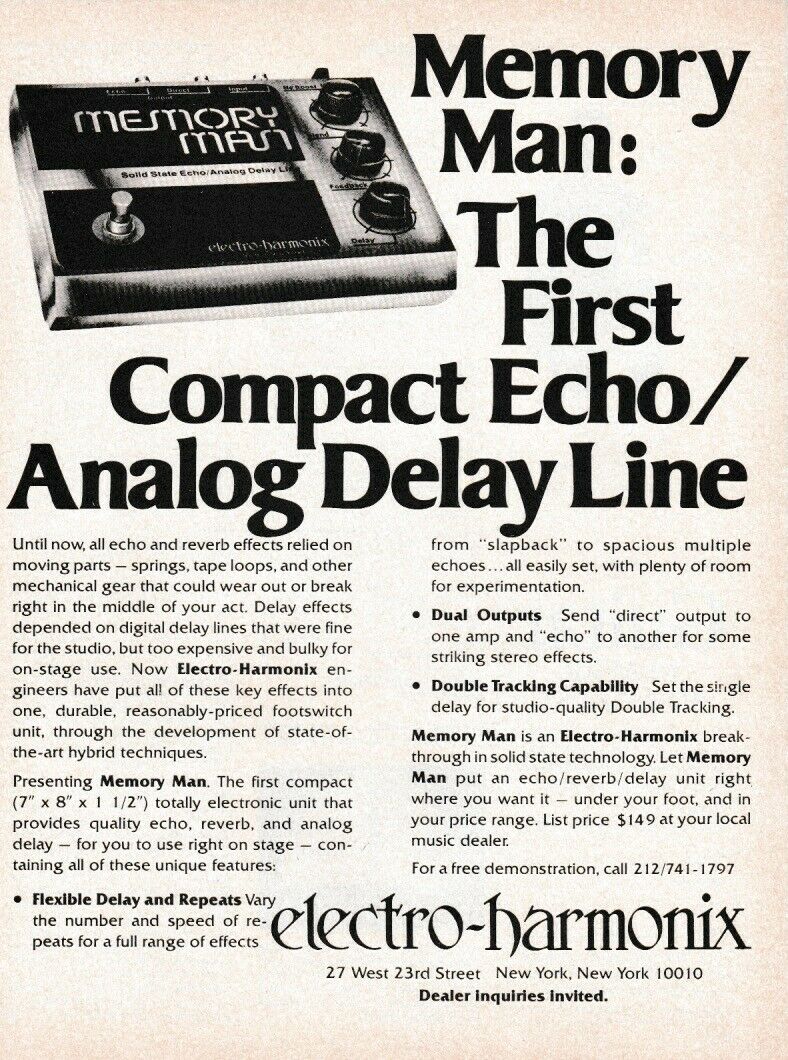 Vintage advertisement for the Memory Man (sourced from EHX)
Vintage advertisement for the Memory Man (sourced from EHX)
A key player in the development of several iconic EHX pedals, including the 16 Second Digital Delay, was designer David Cockerell. No stranger to producing musical instruments, Cockerell previously worked for synthesizer maker EMS—where he had a significant role in the design of the VCS3, Synthi AKS, Synthi 100, and several other commercial and experimental designs. But during a fateful trip to New York in the 1970s, crossing paths with EHX mogul Mike Matthews eventually led to Cockerell's employment as a designer for Electro-Harmonix. Cockerell's first pedal was the classic Small Stone phaser, but he'd have a hand in designing countless cool devices for EHX (among other companies) in the following decades, and continues to do so to this day.
With minds like Cockrell on their design team, EHX has been no stranger to adopting cutting-edge technologies and putting them to use in products at lightning speed. For example, the original Memory Man was advertised as the first compact, pedal-sized delay unit on the market, employing the then-new technology of bucket-bridge devices (BBDs) for analog echo effects that didn't require tape decks. Though we love BBDs for their warm and murky characteristics, for technical reasons they are somewhat flawed as far as fidelity is concerned—especially with longer delay times.
However, thanks to pivotal musical releases like Brian Eno and Robert Fripp's 1972 album (No Pussyfooting) and the subsequent development of their Frippertronics extended delay and looping techniques, there was a growing demand for longer delay times without compromises in fidelity. In that vein, the dawn of the 1980s promised a bright future to those who could wrap their heads around the budding fields of digital technology—and Cockerell was leading the charge for EHX to develop digital pedals catered to the task of delay and looping.
EHX's Earliest Digital Pedals
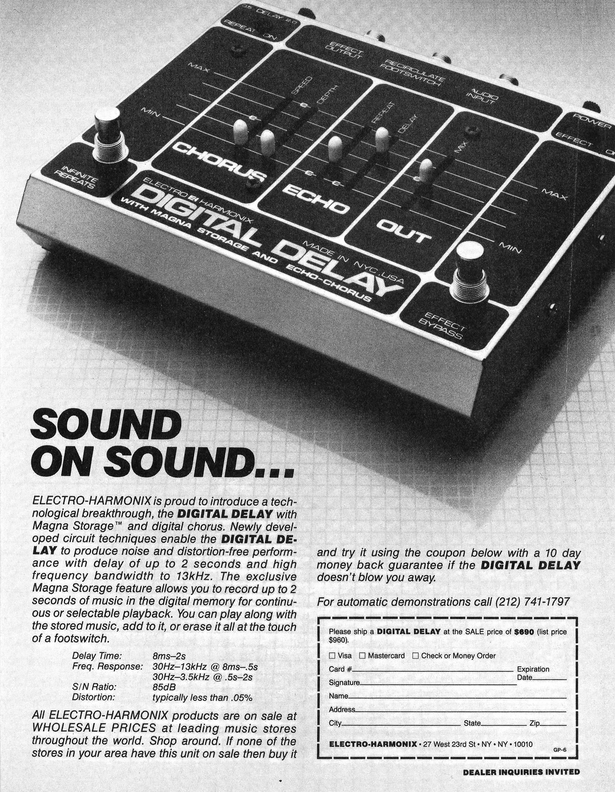 1981 advertisement for the 2 Second Digital Delay Pedal (sourced from EHX)
1981 advertisement for the 2 Second Digital Delay Pedal (sourced from EHX)
While the 16 Second Delay wasn't the very first digital pedal from Electro-Harmonix, this pedal was certainly shaped by a few key products that were released along the way. Launched right at the beginning of the decade, EHX's Instant Replay was a primitive sampler with a sound that can only be described as grimy and highly aliased. While its sound quality and mere one second of sampling time isn't anything to write home about these days, the fact that the Instant Replay offered a variable pitch control and external triggering capabilities was a bit ahead of its time. Nowadays, delay and looper pedals that can behave like simple samplers triggered at the tap of a switch are a dime a dozen—but over four decades ago, EHX did it first.
In 1981, Electro-Harmonix made a big incremental step toward the 16 Second Delay with the aptly named Digital Delay pedal. Containing what EHX called "Magna Storage," Cockerell had refined the digital techniques first explored on the Instant Replay, doubling memory time to two seconds and greatly improving the fidelity of recordings. And barring a few features that would come on the later model, this Digital Delay established the basic form and functionality that the 16 Second Delay would later assume.
Working from the established template of analog delay devices like the Memory Man, the EHX Digital Delay offered delay time and feedback controls, plus a built-in LFO to modulate the delay time and produce chorusing effects. But the notable addition of this pedal was its Infinite Repeats footswitch, which allowed the Digital Delay to infinitely feed its contents back into itself to achieve looping. Playing into the pedal would continuously overdub onto the delay buffer, while anything already recorded would indefinitely recirculate without any loss of frequency content or fidelity.
16 Second Digital Delay Overview
Most of the 16 Second Delay's controls are laid out as sliders across the front panel, with a few other options available as switches along the top. Following in the footsteps of many modulated analog delay devices before it, the 16 Second Delay's parameterization builds upon the prior Electro-Harmonix Digital Delay. However, to facilitate some new additions and the octupled amount of delay memory, some tweaks were made to the familiar delay pedal archetype that would eventually cement the 16 Second Digital Delay as a legendary achievement in the history of delay and looper devices.
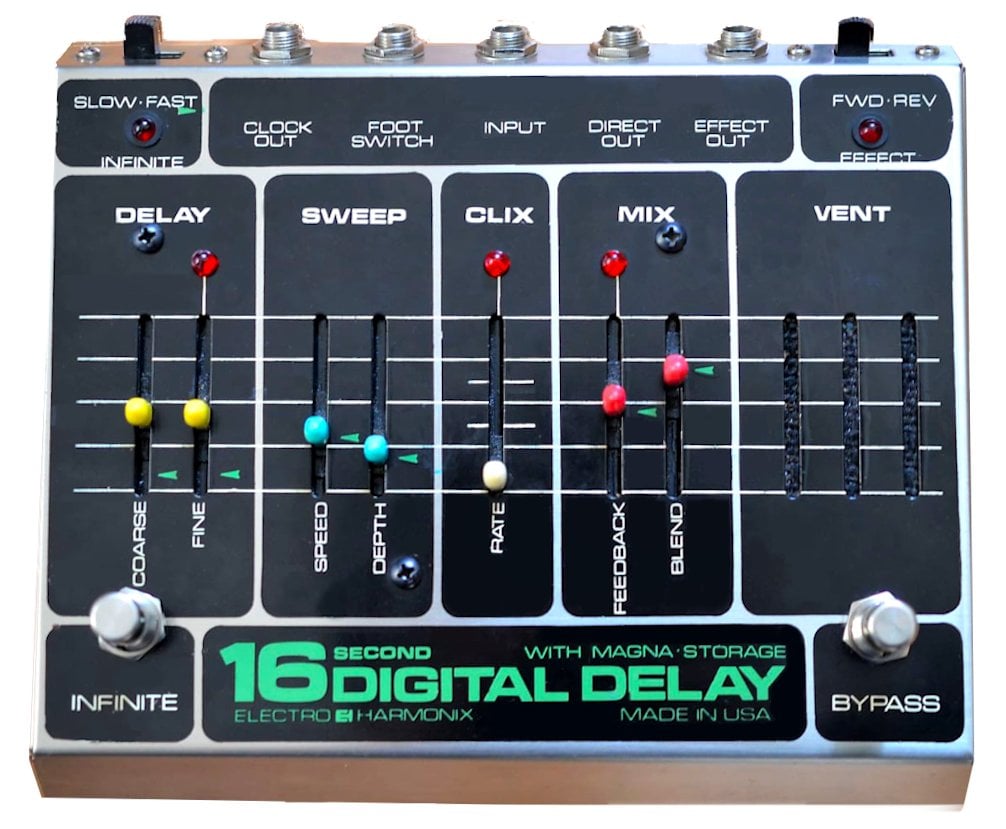
On the 16 Second Digital Delay, setting the duration of the delay or loop is done with the Coarse and Fine sliders, kind of similar to what would be found on a synthesizer to set the pitch of its oscillators. However, the way that these sliders interact with internal delay memory might not be the way you'd initially expect. You could think of the Coarse time as defining the boundaries of the loop—with an analogy to tape, this is the physical length of the tape loop or the distance the tape must travel between being recorded and then played back. If you change this parameter, you suddenly have more or less "tape" to record with. Fine time then determines the rate at which the delay contents are read within those defined bounds, and changing this parameter while recording or playing back a loop will introduce pitch shifting.
These days, 16 seconds of delay or looping time still doesn't seem like all that much, especially in comparison to some of the more complex phrase sampler and loop station pedals out there. But for a first-of-its-kind pedal released in 1983, the EHX 16 Second Delay rivaled the capabilities of premium rackmount delay and looping units that were being released around the same time, with the added bonus of being rather affordable in comparison.
The flexibility of setting delay and loop timings on the 16 Second Delay is extended thanks to the inclusion of the Slow-Fast switch on the back of the pedal. At the "Slow" setting, you get the full 16 seconds of recording time that the pedal has to offer, but bumping it up to "Fast" trades delay time for a bit more fidelity and ease of dialing in slapback-style echoes. And, of course, this also means that flipping the switch with a filled loop buffer will yield octave pitch-shifting. For even more textural fun, there's also a Forward/Reverse switch for backwards playback. Both options were installed as simple slider switches on the rear of the pedal, but if you had the handy-dandy Digital Delay Foot Controller, these were able to be controlled by robust footswitches on the fly.
Another detail worth mentioning about the 16 Second Delay is that it is always listening to and recording the audio coming into it. This means that even when the pedal is "bypassed," engaging the bypass and Infinite switches will begin looping whatever was most recently played into the buffer. This isn't how a modern looper or delay pedal would operate, but it's certainly an interesting performance technique to be playing a passage of music and then suddenly introduce looped accompaniment from silence.
Compared to today's looping devices, the 16 Second Digital Delay is unpredictable, but it's full of happy musical accidents waiting to surprise you. That's not to say that this pedal can't be tamed—guitarists such as Nels Cline and Bill Frisell have embraced the quirks of the 16 Second Delay and seamlessly merged it into their sound. And that's truly the charm of using an open-ended delay platform as a looper: it's less about precision and tight, tempo-locked loops and more about spontaneity and improvisation, almost as if the pedal were another member of your band.
The Curious Clix Circuit
You might have noticed that we omitted one section of the 16 Second Digital Delay in our overview above, and that's because we think it deserves some special attention. One of the quirkiest bits of the 16 Second Digital Delay is the Clix circuit, a circuit devised by Electro-Harmonix to serve as a sort of timing pulse or metronome to aid in the recording of longer loops. In theory, increasing the position of the Clix Rate slider should introduce audible clicks at the output of the pedal that are in time with the delay/loop clock.
However, in practice, rather than producing steady pulses a variety of rhythms will occur due to the specifics of how this circuit was designed. Thus, instead of jumping from, for example, quarter notes to eighths, sixteenths, and so on, intermediary positions will gradually "fill" in gaps between pulses with clicks of the next subdivision—resulting in gallops or rests depending on where the current rate setting falls within the "beat."
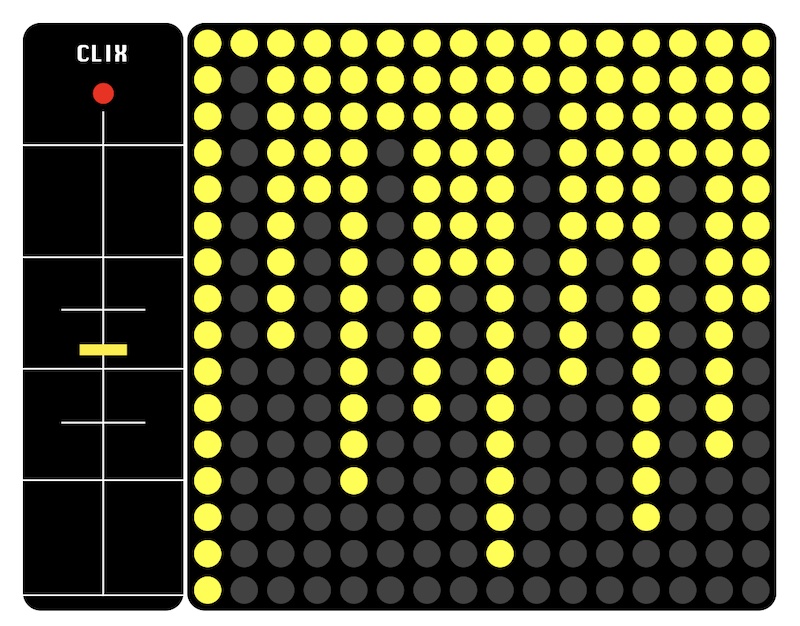
[Above: an approximate diagram of how the Electro-Harmonix 16 Second Digital Delay Clix circuit generates rhythms. Columns from left to right represent "pulses" within the delay/loop time]
Given its peculiar behavior, many guitarists and other musicians hardly ever touched the Clix slider—it was deemed rather untrustworthy for live performances. But one artist to embrace the oddities of this feature was Charles Cohen, an early adopter of Don Buchla's original Music Easel from the 1970s. Through the use of a custom card inserted into the 208 Stored Program Sound Source, Cohen was able to use the Clix output as a clock source for the Easel's sequencer. And because the 16 Second Delay is the source of timing, phrases captured in a loop would always be in time, affording seamless synchronized overdubs.
Considering that this was well before the existence of DAWs or long-form tempo-locked samplers, Cohen was able to craft remarkably dense compositions and performances from effectively one instrument as a soloist. But even beyond synchronized loops, the sheer amount of available delay time plus the broad range of timbres available from the Music Easel created a potent combination for ethereal textures, ominous drones, or drippy bleeps and bloops—a pairing that was frankly way ahead of its time.
Legacy of the 16 Second Digital Delay
Though Electro-Harmonix temporarily closed its doors not long after the release of the original, the revitalized brand has extensive looper offerings these days. Though not exactly like the 16 Second Delay, these include the 45000 Stereo Looper and the Stereo Memory Man with Hazarai, which approach the tasks of digital delay and looping in different ways, but maintain a clear thread to the techniques established with the original.
At one point EHX even offered a reissue of the 16 Second Delay, though it functioned significantly differently from the original version. The reissue features a more distinct boundary between delay and loop functions, with only one second of maximum time in delay mode. Loop mode maintains the 16 seconds of loop time while introducing an optional time stretching mode for the Fine time control for glitched-out manipulations of the loop length without changes in pitch. The Clix circuit is also greatly refined here, offering "bar" and "beat"-style pulses for more metronome-like behaviors.
Today, the closest thing you might get to the original is the Maneco Labs Sixteen Seconds Digital Delay Reissue, a modern take on the classic with a refined Clix circuit and external power supply compatibility. Compared to aging vintage units, the Maneco Reissue offers a generally more reliable design but maintains the spontaneous spirit of the original. It's also much smaller than even the official EHX reissue, so it's more easily adaptable to pedalboard setups. And for the modular synthesis folks out there, Maneco has just introduced a Eurorack version as well, offering some key control voltage and clock signal inputs for true patching integration.
Onward Through Time
Nowadays, looper pedals—and even digital delay—mean something very different than what EHX and others had in mind back in the late 1970s and early 80s. We're pretty privileged to have fancy digital delay and looper pedals today, but remember that there was truly nothing like the 16 Second Digital Delay at the time of its release.
Though the workflow of looping and recording would evolve over time, thanks to the continued improvements of technology, all of those loop station and phrase sampler pedals owe their existence to the benchmark established by the 16 Second Delay. Indeed, the influence and legacy of the 16 Second Digital Delay is immeasurable, and despite all of its quirks, it managed to define essential features and functions for an entire category of effects pedals. And, of course, it both directly and indirectly inspired countless artists to explore the world of looping.


